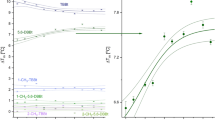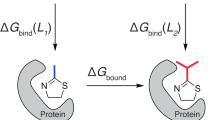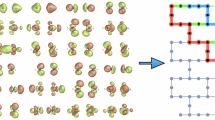Abstract
Aim:
To decipher the molecular interactions between c-Met and its type I inhibitors and to facilitate the design of novel c-Met inhibitors.
Methods:
Based on the prototype model inhibitor 1, four ligands with subtle differences in the fused aromatic rings were synthesized. Quantum chemistry was employed to calculate the binding free energy for each ligand. Symmetry-adapted perturbation theory (SAPT) was used to decompose the binding energy into several fundamental forces to elucidate the determinant factors.
Results:
Binding free energies calculated from quantum chemistry were correlated well with experimental data. SAPT calculations showed that the predominant driving force for binding was derived from a sandwich π–π interaction with Tyr-1230. Arg-1208 was the differentiating factor, interacting with the 6-position of the fused aromatic ring system through the backbone carbonyl with a force pattern similar to hydrogen bonding. Therefore, a hydrogen atom must be attached at the 6-position, and changing the carbon atom to nitrogen caused unfavorable electrostatic interactions.
Conclusion:
The theoretical studies have elucidated the determinant factors involved in the binding of type I inhibitors to c-Met.
Similar content being viewed by others
Log in or create a free account to read this content
Gain free access to this article, as well as selected content from this journal and more on nature.com
or
Accession codes
References
Gherardi E, Birchmeier W, Birchmeier C, Vande Woude G . Targeting MET in cancer: rationale and progress. Nat Rev Cancer 2012; 12: 89–103.
Trusolino L, Bertotti A, Comoglio PM . MET signalling: principles and functions in development, organ regeneration and cancer. Nat Rev Mol Cell Biol 2010; 11: 834–48.
Birchmeier C, Birchmeier W, Gherardi E, Vande Woude GF . Met, metastasis, motility and more. Nat Rev Mol Cell Biol 2003; 4: 915–25.
Peters S, Adjei AA . MET: a promising anticancer therapeutic target. Nat Rev Clin Oncol 2012; 9: 314–26.
Comoglio PM, Giordano S, Trusolino L . Drug development of MET inhibitors: targeting oncogene addiction and expedience. Nat Rev Drug Discov 2008; 7: 504–16.
Giordano S, di Renzo MF, Olivero M, Mondino A, Zhen Z, Medico E, et al. The c-met/HGF receptor in human tumours. Eur J Cancer Prev 1992; 1 Suppl 3: 45–9.
Drebber U, Baldus SE, Nolden B, Grass G, Bollschweiler E, Dienes HP, et al. The overexpression of c-met as a prognostic indicator for gastric carcinoma compared to p53 and p21 nuclear accumulation. Oncol Rep 2008; 19: 1477–83.
Jung KH, Park BH, Hong SS . Progress in cancer therapy targeting c-Met signaling pathway. Arch Pharm Res 2012; 35: 595–604.
Eder JP, Shapiro GI, Appleman LJ, Zhu AX, Miles D, Keer H, et al. A phase I study of foretinib, a multi-targeted inhibitor of c-Met and vascular endothelial growth factor receptor 2. Clin Cancer Res 2010; 16: 3507–16.
Liu X, Newton RC, Scherle PA . Development of c-MET pathway inhibitors. Expert Opin Investig Drugs 2011; 20: 1225–41.
Liu X, Yao W, Newton RC, Scherle PA . Targeting the c-MET signaling pathway for cancer therapy. Expert Opin Investig Drugs 2008; 17: 997–1011.
Porter J . Small molecule c-Met kinase inhibitors: a review of recent patents. Expert Opin Ther Pat 2010; 20: 159–77.
Liu X, Wang Q, Yang G, Marando C, Koblish HK, Hall LM, et al. A novel kinase inhibitor, INCB28060, blocks c-MET-dependent signaling, neoplastic activities, and cross-talk with EGFR and HER-3. Clin Cancer Res 2011; 17: 7127–38.
Albrecht BK, Harmange JC, Bauer D, Berry L, Bode C, Boezio AA, et al. Discovery and optimization of triazolopyridazines as potent and selective inhibitors of the c-Met kinase. J Med Chem 2008; 51: 2879–82.
Wheeler SE . Understanding substituent effects in noncovalent interactions involving aromatic rings. Acc Chem Res 2013; 46: 1029–38.
Chakrabarti P, Bhattacharyya R . Geometry of nonbonded interactions involving planar groups in proteins. Prog Biophys Mol Biol 2007; 95: 83–137.
Rozas I . On the nature of hydrogen bonds: an overview on computational studies and a word about patterns. Phys Chem Chem Phys 2007; 9: 2782–90.
Zacharias N, Dougherty DA . Cation-pi interactions in ligand recognition and catalysis. Trends Pharmacol Sci 2002; 23: 281–7.
Valero R, Gomes JR, Truhlar DG, Illas F . Good performance of the M06 family of hybrid meta generalized gradient approximation density functionals on a difficult case: CO adsorption on MgO(001). J Chem Phys 2008; 129: 124710.
Valero R, Costa R, de PRMI, Truhlar DG, Illas F . Performance of the M06 family of exchange-correlation functionals for predicting magnetic coupling in organic and inorganic molecules. J Chem Phys 2008; 128: 114103.
Zhao Y, Truhlar DG . Density functionals with broad applicability in chemistry. Acc Chem Res 2008; 41: 157–67.
MOPAC 6.0 for Windows 95. Nachr Chem Tech Lab 1997; 45: 406.
Marenich AV, Cramer CJ, Truhlar DG . Universal solvation model based on solute electron density and on a continuum model of the solvent defined by the bulk dielectric constant and atomic surface tensions. J Phys Chem B 2009; 113: 6378–96.
Jeziorski B, Moszynski R, Szalewicz K . Perturbation-theory approach to intermolecular potential-energy surfaces of Van-Der-Waals complexes. Chem Rev 1994; 94: 1887–930.
Szalewicz K . Symmetry-adapted perturbation theory of intermolecular forces. Wires Comput Mol Sci 2012; 2: 254–72.
Turney JM, Simmonett AC, Parrish RM, Hohenstein EG, Evangelista FA, Fermann JT, et al. PSI4: an open–source ab initio electronic structure program. Wires Comput Mol Sci 2012; 2: 556–65.
Hohenstein EG, Parrish RM, Sherrill CD, Turney JM, Schaefer HF . Large-scale symmetry-adapted perturbation theory computations via density fitting and Laplace transformation techniques: Investigating the fundamental forces of DNA-intercalator interactions. J Chem Phys 2011; 135: 174107–19.
Hohenstein EG, Sherrill CD . Efficient evaluation of triple excitations in symmetry-adapted perturbation theory via second-order Moller-Plesset perturbation theory natural orbitals. J Chem Phys 2010; 133: 104107–14.
Hohenstein EG, Sherrill CD . Density fitting of intramonomer correlation effects in symmetry-adapted perturbation theory. J Chem Phys 2010; 133: 014101–12.
Ye LB, Tian YX, Li ZH, Jin H, Zhu ZG, Wan SH, et al. Design, synthesis and molecular docking studies of some novel spiro[indoline-3,4′-piperidine]-2-ones as potential c-Met inhibitors. Eur J Med Chem 2012; 50: 370–5.
Hunter CA, Sanders JKM . The nature of Pi–Pi interactions. J Am Chem Soc 1990; 112: 5525–34.
Ringer AL, Sherrill CD . Substituent effects in Sandwich configurations of multiply substituted benzene dimers are not solely governed By electrostatic control. J Am Chem Soc 2009; 131: 4574–5.
Arnstein SA, Sherrill CD . Substituent effects in parallel-displaced pi–pi interactions. Phys Chem Chem Physics 2008; 10: 2646–55.
Ringer AL, Sinnokrot MO, Lively RP, Sherrill CD . The effect of multiple substituents on sandwich and T-shaped pi-pi interactions. Chemistry 2006; 12: 3821–8.
Sherrill CD . Substituent effects in Pi–Pi interactions: electrostatics vs dispersion. Abstr Pap Am Chem S 2004; 228: U62.
Watt M, Hardebeck LKE, Kirkpatrick CC, Lewis M . Face-to-Face Arene-Arene binding energies: dominated by dispersion but predicted by electrostatic and dispersion/polarizability substituent constants. J Am Chem Society 2011; 133: 3854–62.
Wheeler SE, Houk KN . Substituent effects in cation/pi interactions and electrostatic potentials above the centers of substituted benzenes are due primarily to through-space effects of the substituents. J Am Chem Soc 2009; 131: 3126–7.
Wheeler SE, Houk KN . Substituent effects in the benzene dimer are due to direct interactions of the substituents with the unsubstituted benzene. J Am Chem Soc 2008; 130: 10854–5.
Daeffler KNM, Lester HA, Dougherty DA . Functionally important aromatic-aromatic and sulfur-pi interactions in the D2 dopamine receptor. J Am Chem Soc 2012; 134: 14890–6.
Morgado CA, McNamara JP, Hillier IH, Burton NA . Density functional and semiempirical molecular orbital methods including dispersion corrections for the accurate description of noncovalent interactions involving sulfur-containing molecules. J Chem Theory Comput 2007; 3: 1656–64.
Tauer TP, Derrick ME, Sherrill CD . Estimates of the ab initio limit for sulfur-pi interactions: The H2S-benzene dimer. J Phys Chem A 2005; 109: 191–6.
Acknowledgements
The authors wish to thank Prof Ming-yue ZHENG for his critical reading of the manuscript. We are grateful for financial support from the Program of Excellent Young Scientists of the Chinese Academy of Sciences to Bing XIONG (Grant No KSCX2-EW-Q-3-01), from the National Natural Science Foundation of China to Bing XIONG (Grant No 81072580), and from the “Interdisciplinary Cooperation Team” Program for Science and Technology Innovation of the Chinese Academy of Sciences.
Author information
Authors and Affiliations
Corresponding authors
Additional information
Supplementary Table is available at the Acta Pharmacologica Sinica website.
Supplementary information
Supplementary Table S1
Energy of various models in gas phase with M06-2X/6-31G+(d) methods (energy unit is AU except for salvation free energy, 1AU=627.51 kcal/mol) (PDF 474 kb)
Rights and permissions
About this article
Cite this article
Yu, Z., Ma, Yc., Ai, J. et al. Energetic factors determining the binding of type I inhibitors to c-Met kinase: experimental studies and quantum mechanical calculations. Acta Pharmacol Sin 34, 1475–1483 (2013). https://doi.org/10.1038/aps.2013.85
Received:
Accepted:
Published:
Issue date:
DOI: https://doi.org/10.1038/aps.2013.85
Keywords
This article is cited by
-
Discovery of a new series of imidazo[1,2-a]pyridine compounds as selective c-Met inhibitors
Acta Pharmacologica Sinica (2016)
-
Design, synthesis and biological evaluation of N-phenylalkyl-substituted tramadol derivatives as novel μ opioid receptor ligands
Acta Pharmacologica Sinica (2015)



